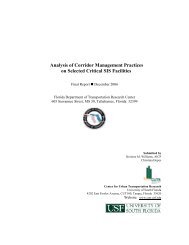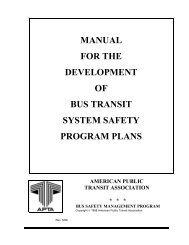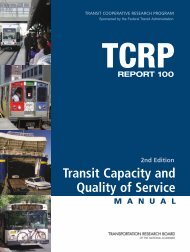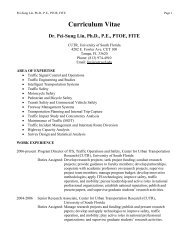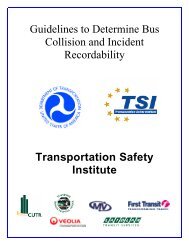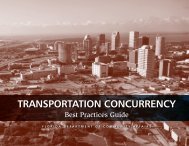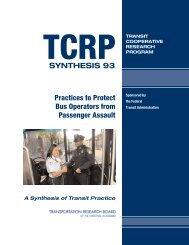a technical guide for conducting pedestrian safety assessments
a technical guide for conducting pedestrian safety assessments
a technical guide for conducting pedestrian safety assessments
You also want an ePaper? Increase the reach of your titles
YUMPU automatically turns print PDFs into web optimized ePapers that Google loves.
UNIVERSITY OF CALIFORNIA BERKELEY • INSTITUTE OF TRANSPORTATION STUDIES • TECHNOLOGY TRANSFER PROGRAM<br />
15<br />
TABLE 4: PROGRAMS, PRACTICES, AND POLICIES: PRE-VISIT INTERVIEW<br />
Interview Topic Subtopic Suggested Interview Questions<br />
Planning Programs, Practices, and Policies<br />
Pedestrian Master<br />
Plan (continued)<br />
General Ordinances<br />
Routine<br />
Accommodations/<br />
New Development<br />
Transit<br />
Public Involvement<br />
• How much did you spend on bicycle/<strong>pedestrian</strong> improvements<br />
on average over the past 3 to 5 years (versus bicycle and<br />
<strong>pedestrian</strong> mode shares)?<br />
• Do you have a Bicycle/Pedestrian Coordinator(s) on staff?<br />
• What percentage of time do they devote to <strong>pedestrian</strong> related<br />
work?<br />
• Which funding sources are typically used to fund improvements<br />
identified in your Master Plan?<br />
• Did you substantially integrate the needs of <strong>pedestrian</strong>s in<br />
your latest update to your General Plan, Transit Plans, Parks<br />
Plans, School Renovation Plans (especially including policies<br />
and practices requiring all new development to be <strong>pedestrian</strong><br />
supportive)?<br />
• Do you have a newspaper rack ordinance?<br />
• Do you have a street furniture ordinance?<br />
• Do you have a bicycle parking ordinance?<br />
• Do you have a (street) tree ordinance?<br />
• Do you have open space requirements?<br />
• Do you require neighborhood sized schools?<br />
• Do you assess impact fees <strong>for</strong> new development programs to<br />
pay <strong>for</strong> transportation impact mitigations? If so, are these<br />
fund used <strong>for</strong> <strong>pedestrian</strong> infrastructure improvement? How<br />
are they distributed?<br />
• Do you have a routine accommodation, or complete streets,<br />
policy to consider <strong>pedestrian</strong> needs within all infrastructure<br />
projects?<br />
• If yes, how does this apply to the development review<br />
process? How does this apply during the planning, design,<br />
construction, and operations phases?<br />
• Do you require a high level of street connectivity <strong>for</strong> new<br />
projects?<br />
• What are your <strong>guide</strong>lines and practices <strong>for</strong> large commercial<br />
developments to provide safe and convenient access to<br />
buildings?<br />
• Do you have a Transit First Policy?<br />
• What are your policies regarding transit shelters and <strong>pedestrian</strong><br />
connections to transit stops/stations (request a typical<br />
site plan <strong>for</strong> a new transit stop)?<br />
• Does your city have a Travel Demand Management (TDM) Program<br />
or Coordinator?<br />
• Are businesses that offer free parking to employees required<br />
to offer a cash-out alternative?<br />
• Do city employees or other groups have access to EcoPasses,<br />
CommuterChecks, etc.?<br />
• Do you have a committee that addresses <strong>pedestrian</strong> issues<br />
(Pedestrian Committee (sometimes combined with a Bicycle<br />
Committee), Parks, or Recreation Committee)?



